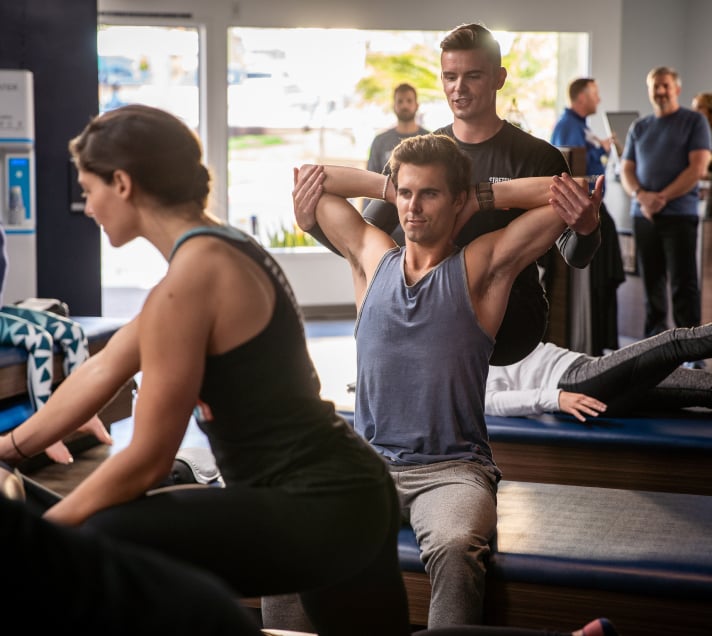Are you curious about how an assisted stretch is different from a massage? Both have their place in our self-care protocols for our clients. Many similarities as well as many nuanced differences.
Let’s break down what each is and when they are best utilized to provide the most benefit. First, assisted stretching is done in an interactive manner.. During a session at StretchLab you will need to be engaged and provide feedback on what you are feeling and noticing. Whereas massage is done in a more passive manner. Massage is a great service for many things such as helping with circulation, helping to relax, it can help with general muscle soreness due to DOMS (Delayed Onset Muscle Soreness),and it can be a great place for a person to start to understand their own bodies. Typically the practitioner will utilize techniques such as petrissage(kneading, lifting, wringing, and rolling), effleurage(gliding strokes using the palms, fingers, etc.), cross-friction(going against the muscle striation to break up adhesions), tapotement (tapping type movement) or any combination of. These techniques work on the superficial layer of muscle and provide some mobilization of the fascial structures as well. A senior Flexologist in Morristown, NJ gave a great description
“Massage therapy can be wide and vast, but what we generally think of massage is to soften and release muscle tissue. This provides a deep sense of relaxation by experiencing the effects of the parasympathetic response of the autonomic nervous system which is absolutely necessary for restoration and recovery of the body, mind and emotion. Whereas with stretching (Flexologist role) it cultivates a great aspect of mobility including the range of motion and flexibility which are a major factor in injury prevention, recovery, less pain and more positive gains.”
John Levis (Senior flexologist in Morristown, NJ) LMT, Flexologist, Thai bodyworker, 1000+ hour yoga instructor, ART practitioner, NMR, and AK
Stretching on the other hand has been shown to help create more long term benefits. We work with our clients and utilize different types of stretching to help them achieve a better quality of life. Below are some of the different types of stretching.
Static Stretching: This is when you are either put into a stretch, or you go into a stretch and are holding for at least 20 seconds or more. It helps to relax the nervous system.
Dynamic: Fluid movement that is preparing the body for the work it needs to perform. It is stimulating the nervous system to respond in a health productive way.
Fascial: Is assistive by nature and works on the connective tissue of the joint capsule and fascial structures within the body. It is pain free and is meant to help alleviate restrictive patterns that may arise.
PNF: Proprioceptive Neuromuscular Facilitation- in short it helps to gain more range of motion by working with the Myotatic & Golgi Organ Reflex. It helps us teach the body what is a safe movement and what is not. Many times our nervous system is scared to allow more range due to many mitigating factors. The utilization of contract and release methods helps create healthier movement patterns and can assist in trauma based restrictive patterns.
For many of us we think that massage is the best technique to decrease pain for many individuals. As more studies surface they are finding more positive outcomes with static stretching and specific PNF administered techniques. Utilizing PNF stretching creates a resilience in the body to understand what is a safe movement pattern and what is not. It allows for more stability and integration of those connections and for more fluid movement that allows their bodies to gain space and freedom. So many factors can create dysfunctional patterns in the body. Our work with our clients provides a space for education and retraining of those patterns. We are peeling the layers back in a way that allows the body to feel safe and strong. Without that it is very difficult to have an impact.
Stretching and massage have their place and can work well together. Your Flexologist may utilize Trigger Point products as well as the Hypervolt to help with soft tissue.. When administered together it can have a tremendous impact on your results and overall range of motion.
Ready to feel the StretchLab difference?



